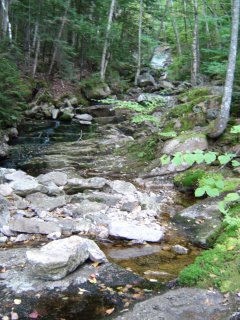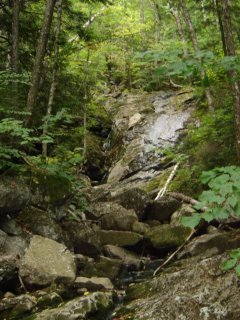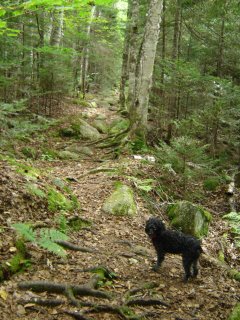Day Three: 13Sept2006




Another cold night, frost on the ground and roofs. A light cloud cover by morning's light with a scattered, light fog. Button and Riley had their post-breakfast sniff-fest on the grounds, Irving wandering about after them, with his second cup of breakfast coffee.
We would go, we decided, back to the White Mountain National forest, this time to hike Fletcher's Cascade Trail, which we'd done years ago when the children were young and so were we. We had started out on this trail on our earlier visit in June under a light rain, but the water level then had kept us from crossing Drake's Brook to enable us to continue the ascent in search of Fletcher's Cascade. Counting on a lower water level this time around, we resolved to try again.
One other vehicle present when we parked at the trailhead. We felt pretty good, thought we were in fine shape after yesterday's climb, but I inwardly groaned even at the gentle ascent starting out on an old logging road before reaching the cut-off to the trail. A beautiful trail, with dogwood everywhere, along with arching ferns, bunchberry, under the forest trees - huge old hemlock, yellow birch, maples, pines and firs. A damp trail, plenty of fungi, mosses, lichen. Goldenrod, asters, leafy remnants of Ladies slippers, lilies of the valley, and trilliums in abundance.
Once on the trail, we negotiate roots and scattered rocks, bunchberry and wood sorrel alongside the trail in decorative mode. High above the harsh caws of ravens, closer by the persistent rattling of a determined woodpecker. We follow along the banks of the creek to our right, vast expanses of smooth grey granite lining the stream. To our left, an inadequate screen of trees, a feeble attempt to hide the ongoing clear-cutting of the forest, marring the landscape.
The trail grew narrower, indicating it has been little-used of late, lush green growth pressing from the forest upon the relative and narrow clearing expressing the trail. Time and again we cross narrow rivulets, handily hopping from rock to outcrop to make the breach. From time to time the trail turns to bog, dark slippery muck, well recalled from our earlier, aborted attempt. We take brief alternative dips into the forest, briefly bushwhacking, then regaining the trail.
The clouds deepen, casting gloom below. From time to time the gloom lifts as the sun peeks briefly through the cloud cover, to illuminate dangling red dogwood berries, sensitive ferns, a cluster of mushrooms. Finally, steadily ascending, we approach the crossing that had halted our progress months earlier and it is clear as we approach and hear the water churning over the rocks, lacking the emphasis of a full stream, that we're in luck.
Many potential crossing opportunities present themselves this time, a happy contrast to the frustration we experienced trying one site after another last time, to little avail. Boulders, rocks, large and small are tumbled across the creek, the water level sufficiently low to permit easy access to the other side and the continuation of the trail. Button has no trouble crossing after Irving, slipping a bit into the water at one point, but leaping effortlessly after that from one rock to another.
I lift little Riley and set off, seeking secure footing from rock to rock. Manage to slither off my purchase twice, the second time into the shallows, hoping my boots are sufficiently water-proofed to ensure they and I don't get soaked. My momentum keeps me going and we make the crossing expeditiously. I heave myself after Irving up a steep gradient in the bank where protruding roots hold soil shelves in place.
The path weaves toward the side of the mountain becoming steadily steeper as we plow wearily onward. Button and Riley come to a perplexed standstill before the corpse of a forest behemoth blockading the trail. I clamber over it, a gentle pine trunk of immense girth, and receive first Button then Riley as they are handed over.
We're trying to recall what the terrain we're traversing is leading to, but cannot, there have been so many other climbs, so many intervening years. But we're slowly and steadily ascending as the trail becomes steeper by the minute. Irving keeps telling me to be patient, because I've begun grousing about the effort to pull myself up; we'll soon be there, he says encouragingly. On we plod, and for what, I ask myself. Why two 70-year-olds would inflict this punishment on their ageing bodies eluded me just then as I panted for breath, resting, shoving upward again. No relief at all at this point, just a steeply root-crossed, stone-littered trail.
Finally, there appears an opening, a vista, and we can see a long, perpendicular sweep of rock, reaching to the sky. Below it a series of sandwiched rock formations. No roar of water though, and as we approach the long rock slide came into finer view along with its lower shelves. Two aluminum, webbed camp chairs had been placed on the lower shelves. Up here? Where the owners? Someone's weird sense of humour? Well, nature had gone one better.
A thin stream of water dropped listlessly down the long expanse, found its way over the shelves. Observe! the fabulous cascades. A small flock of chickadees flitted among the trees on the opposite side, the rubber-ducky sound of the nuthatch accompanying them mocking us, below.
We take photographs of that geologic anomaly and its wonderful stone features. Sit around on the rock ledge, doing our best to ignore the aluminum folding chars; an insult to the landscape. Offer water and doggy treats to our companions, then begin the surprisingly swift ascent; the 1.7 miles return didn't quite match the 1.7 miles to get there and thank heavens for small mercies.
I had my answer: 70-year-olds do such things to enjoy and celebrate nature and our place in her kingdom of earthly delights. And, needless to say, because we (still) can.

<< Home